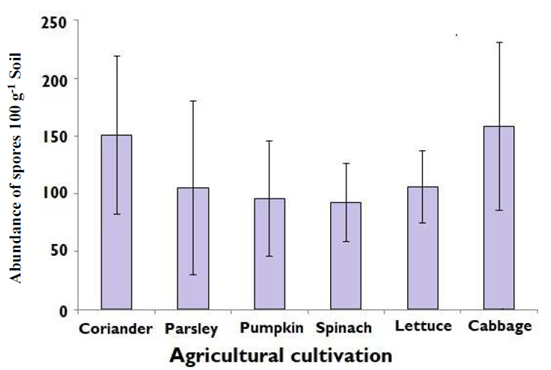Arbuscular Mycorrhizal Fungi Consortia in Six Vegetable Crops in the Tepeaca Valley, Puebla, Mexico
DOI:
https://doi.org/10.28940/terra.v42i0.1783Abstract
The objectives of this work were to search for and evaluate arbuscular mycorrhizal fungi (AMF) in six crops of agricultural importance in the horticultural region of Tepeaca valley, Puebla, Mexico, where Cambisols type soil predominates since the communities and consortia of AMF and their functionality in various crops of economic importance in Mexico are still unknown. The search for and identification of AMF spores was carried out in dif ferent vegetable crops. Five subsamples were collected from 6 dif ferent crop fields with vegetables (cilantro, cabbage, spinach, parsley, lettuce, and pumpkin); each subsample consisted of soil and roots. Roots 5 mm long were selected and stained using the Phillips-Hayman technique. Spore extractions and physicochemical determinations (soil texture, pH, relative humidity (RH), and electrical conductivity (EC)) were performed from soil. The results obtained from staining showed vesicles and spores in roots except in the pumpkin subsamples; of spore extractions from the soil of the six crops, 9 genera and 14 morphotypes of mycorrhizae were found, highlighting Funneliformis mosseae, Claroideoglomus Claroideum, and Glomus sp. as dominant species. By soil physicochemical characterizations were found: sandy texture, pH between 5.8 to 6.8; RH of 9.4 to 13%, and EC of 0.10 to 0.93 mS cm-1. In conclusion, the analyses of similarity and main components suggested that species of vegetables and soil conditions do not af fect the spore abundance, but they do af fect the richness and composition of AMF species, observing particular mycorrhizal consortia for each crop; therefore, it is suggested to evaluate their ef fectiveness in each of the crops to promote them as biofertilizer in the agricultural region of Tepeaca valley, Puebla, Mexico.
Downloads
Publication Facts
Reviewer profiles N/A
Author statements
- Academic society
- Terra Latinoamericana
- Publisher
- Mexican Society of Soil Science, C.A.

















